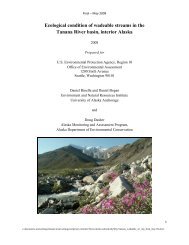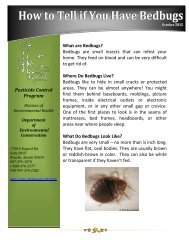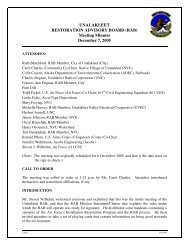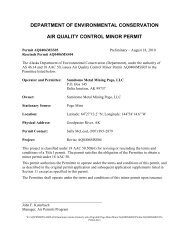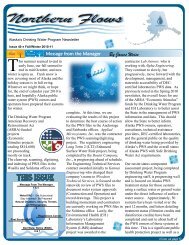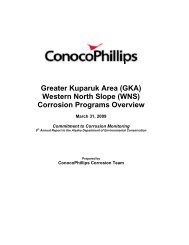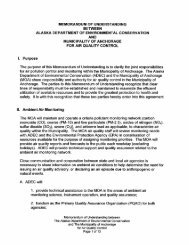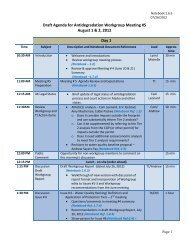2012 Ocean Ranger Guidebook Revision 3-7-12 - Alaska ...
2012 Ocean Ranger Guidebook Revision 3-7-12 - Alaska ...
2012 Ocean Ranger Guidebook Revision 3-7-12 - Alaska ...
You also want an ePaper? Increase the reach of your titles
YUMPU automatically turns print PDFs into web optimized ePapers that Google loves.
<strong>20<strong>12</strong></strong> <strong>Ocean</strong> <strong>Ranger</strong> <strong>Guidebook</strong> 3-7-<strong>12</strong><br />
Job Aid Item: 1.1.d<br />
Text: Check for unpermitted discharges of untreated wastewater, treated wastewater by unpermitted<br />
vessels, discharge in areas closed to discharge, or discharge of sludge or biosolids in <strong>Alaska</strong> waters. (AS<br />
46.03.462, AS 46.03.463, GP, 18 AAC 72.055).<br />
Background: Cruise ships in <strong>Alaska</strong> are required to only discharge treated wastewater in <strong>Alaska</strong>n waters<br />
and the Alexander Archipelago (AS 46.03.462&463, 33CFR 159.307&309). Discharge of untreated<br />
wastewater in these areas is prohibited. Wastewater that is discharged must meet all federal and state<br />
requirements for treatment and can only be discharged where permitted. Wastewater discharge in<br />
<strong>Alaska</strong>n waters requires a state permit (2010 Large Commercial Passenger Vessel Wastewater Discharge<br />
General Permit).<br />
Title XIV (the “Murkowski law”) allowed the state of <strong>Alaska</strong> to regulate wastewater discharge for<br />
large cruise ships within <strong>Alaska</strong>n waters and also within some areas in the Alexander Archipelago that<br />
are outside of 3 nautical miles (nm) but within US territorial waters. This closed the “doughnut holes”<br />
located in the Inside passage in Southeast <strong>Alaska</strong>. The boundaries are included in the General Permit<br />
and the reference GP Map in this <strong>Guidebook</strong>.<br />
The Wastewater General Permit does not include Glacier Bay National Park and Preserve, any<br />
discharge there would be unpermitted. The General Permit also prohibits discharge to impaired or<br />
water quality limited waters. The only scheduled location cruise ships visit with impaired waters is<br />
Skagway, discharges in Skagway harbor are prohibited.<br />
The General Permit also has limitations on the type of discharges. Discharges must be from an<br />
Advanced Wastewater Treatment System and cannot contain oily sheens, large amounts of foam,<br />
floating solids, garbage, grease, or sediments and sludge that does not meet the standards required for<br />
wastewater discharge (GP1.3).<br />
A frequent question is discharge in the waters of Tracy Arm. Discharge restrictions for Tracy<br />
Arm are by a voluntary agreement only. There is no regulatory prohibition on discharge of treated<br />
wastewater in Tracy Arm. Discharges may violate the voluntary agreement, company policies, or public<br />
statements- but these are not violations of federal or state law.<br />
About 5-10 percent of the treated WW volume is “bio sludge” / “biosolids” these solids are kept<br />
in holding tanks, although some vessels dry this sludge and incinerate. The sludge could also be<br />
discharged outside <strong>12</strong> nm. Tank storage determination of the volumes should by documented and<br />
understood by the OR. Some vessels appear to clean out the biosludge manually from the AWTS system<br />
tanks / AWTS system. The sludge / solids are stored in drums / large garbage cans for later disposal.<br />
Such operations should be reported and documented.<br />
What to check: Check discharge logs for any entries documenting accidental or emergency discharges.<br />
Check discharge log entries for locations of discharge that show unpermitted WW discharge. Check that<br />
listed discharge amounts did not exceed the design capacity of the treatment plant. Check overboard<br />
ports are closed on non-discharging vessels in <strong>Alaska</strong>n waters, and on discharging vessels in those areas<br />
they cannot discharge. Monitor for unusual activities. Watch for foam, solids, oily sheens, unusual smells<br />
in the waters around the cruise ship.<br />
7






